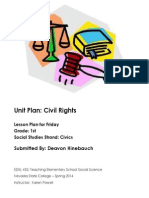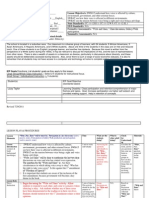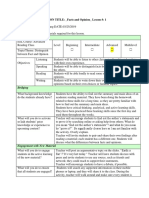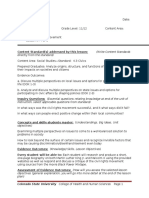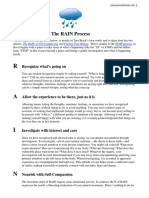HLTP 5 Pta
HLTP 5 Pta
Uploaded by
api-312582463Copyright:
Available Formats
HLTP 5 Pta
HLTP 5 Pta
Uploaded by
api-312582463Original Title
Copyright
Available Formats
Share this document
Did you find this document useful?
Is this content inappropriate?
Copyright:
Available Formats
HLTP 5 Pta
HLTP 5 Pta
Uploaded by
api-312582463Copyright:
Available Formats
1
HLTP 5 PTA Revised for TD 556
The following questions below follow the Plan, Teach, Analyze (PTA) model.
1. Title of class (e.g. 11th grade American Literature, AP History, French II)
World History 2
2. Context of the Whole-Class Discussion. What has the class been studying? What do
students already know? What challenges might students have? How does your discussion,
described below, fit in this context?
We have been studying The French Revolution, and the causes specifically that led to
the Revolution and the early events that transpired during the French Rev. The
students have background knowledge of the causes of the French Rev. and basic
notes on the major events that took place during French Revolution. Students
might have trouble connecting the dots between events of the French Rev with each
other, and with other real world situations that were happening in the world at that
time and real world situations relating today to the French Rev events. The
discussion we have talks about the Declaration of Rights of Man compared to the
Declaration of rights of Women. The DOROMAC is a famous document that
guaranteed citizens (men) natural rights. It is similar to the declaration of
Independence and the bill of rights, with many things taken from it. De Gouges was
upset that women were not included in this document guaranteeing rights so she
made her own document that included women. We have a discussion comparing
these two documents to each other, and with other events, and how and why they
were important and influential in the revolution and still can be applied to todays
world.
3. How did you work with your cooperating teacher in this? Did you plan this wholeclass discussion with your teacher? Please elaborate.
My CT does a lot with the DOROMAC document so he has questions and ideas for that
which I looked at as a guide. I have almost all girls in my WH2 class so I wanted to
bring a female influence into the discussion and we had previously learned about an
enlightened thinker who had an influence on the French Rev who was a woman and
she inspired the writing of the DOROWAC. I decided to have the students get in
pairs and one student would read the DOROMAC and the other read the
DOROWAC. Then they shared ideas and thoughts about the one they read with the
other, before we had a group discussion about the documents.
4. Plan: share your written plans and note specifically your prepared discussion
questions/statements around the content.
A handout with the documents was given to each student. Then the students got into
pairs and one read one document while the other read the other. After they finished
reading they shared their thoughts with each other about the documents in relation to the
questions and then they had to write down a response to the discussion questions
attached to the documents. After they had discussed and written down their responses
we had a class discussion about the documents and the questions.
The questions the students had to write a response for and that we talked about were:
What were the links between the Declaration of the Rights of Man and the Declaration
of the Rights of Women? How were these documents influenced by Enlightenment
thinking? What rights do they state that citizens should have? Who does each
document define as citizens? How are these documents related to the Bill of rights?
5. Analyze: Using the evidence you have available, make claims about the
whole-class discussion with respect to the content, the moves you made as a
teacher, and your students contributions. Additionally, use evidence to make
a case for how you need to improve this practice. Make your claims
complex that is, not simply yes-no or good/bad. In all cases, you should
substantiate your analysis with reference to specific evidence
a. Claim 1: Content is appropriate and provides opportunities for meaningful
discussion.
I think the content is very explicit and clear to the students. They have the
documents in front of them that we are discussing, and they had time to write
down responses and chat with their partner before the whole group discussion
ensued. I did not say the Social studies standards to the students before we
started the discussion. This is something I should work on to ensure students
always know what we are doing, and why we are doing it. It is easier and more
obvious for a lot of things, but when we started the discussion I was not
prepared to have the specific standards for the students. Obviously I wanted
the students to gain an understanding of the French rev. and the relation these
documents had to each other and to others that were new at that time, but it
shouldve been stated.
b. Claim 2: Questions and statements encourage students to practice listening,
speaking, and interpreting each others responses (what the teacher says and
does to manage the discussion).
I think I did a fairly good job as a new teacher leading the class discussion.
The start of the discussion could have been more engaging perhaps, but the
students got engaged fairly quickly I think. My re-questioning attempts and
drawing things out of students went well and helped clarify thoughts and ideas
students got up. There was decent student-to-student interaction but I would
have liked to get them to converse with themselves more than just me and this
is something I will try and improve on. I think I moved the discussion along well
and it made sense chronologically and within the context of the lesson and the
major ideas we were talking about.
c. Claim 3: Numerous students contribute orally, listen actively, respond to, and
learn from each others contributions (illustrative STUDENT statements, actions,
and questions).
It took a minute to get the discussion rolling well, but once it did students started chiming
in more on their own. I think the students were engaged with each other just a bit
apprehensive to talk until something that was said sparked a comment out of them. I
tried to call on new people and get them involved with the discussion as the lesson went
on, and it worked for the most part.
6. Reflect: With respect to the claims above what did you learn from your efforts
in: Leading a Whole-Class Discussion. What might you consider for future
efforts? Any problems or questions that came up?
Maybe it would have been better to illuminate the students with the standards we were
looking for after the discussion was over. I said earlier that I should have stated
them before the discussion but, now thinking about I might not want to give the
answers to them, I want to pry them out of them and then make sure they
understood what we came up with as a class was what the standards we were
actually looking for.
I would have liked more student to student interaction with each other as opposed to me
doing more leading. There were a couple times where the students held the
conversation with themselves for brief moments and then I had to pick it back up
and set it rolling again, so it would be a goal of mine to get them to carry it more on
their own next time.
7. Anything else? Im interested in hearing your relevant thoughts (optional).
It was a good exercise, I thought it would be easy and common sense to do this but
there are so many little nuances and tricks that Im sure doing more discussions with the
class would help me achieve my goals.
You might also like
- Jerome Bruner Acts of MeaningDocument200 pagesJerome Bruner Acts of Meaningalice nie100% (7)
- Synthesis Paper On Leadership - Theresa ShinDocument8 pagesSynthesis Paper On Leadership - Theresa Shinapi-246558507No ratings yet
- 3.5 Newspeak: The Evidence For and Against The Sapir-Whorf HypothesisDocument4 pages3.5 Newspeak: The Evidence For and Against The Sapir-Whorf HypothesisnadiaNo ratings yet
- LECTURE 4 185655 - Postmodern Legal TheoryDocument17 pagesLECTURE 4 185655 - Postmodern Legal Theoryveercasanova100% (1)
- Video Analysis - Current Poltical Social EventDocument4 pagesVideo Analysis - Current Poltical Social Eventapi-252392463No ratings yet
- Lesson 10 Are Human Rights UniversalDocument14 pagesLesson 10 Are Human Rights UniversalCON REGASPINo ratings yet
- STEPP Lesson Plan Form: Colorado State University College of Health and Human Sciences Page 1Document8 pagesSTEPP Lesson Plan Form: Colorado State University College of Health and Human Sciences Page 1api-339779580No ratings yet
- Edel453 Spring2013 Laquishajohnson Unit 4 Civics Day 1Document3 pagesEdel453 Spring2013 Laquishajohnson Unit 4 Civics Day 1La'Quisha JohnsonNo ratings yet
- Jamies Ubd Lesson Plan No 2Document3 pagesJamies Ubd Lesson Plan No 2api-301683382No ratings yet
- 5 Day Lesson Plan RevisedDocument10 pages5 Day Lesson Plan ReviseddylanscharfNo ratings yet
- DEBATE - Important For EveryoneDocument7 pagesDEBATE - Important For EveryoneIvy Rose AlivioNo ratings yet
- Learning Engagement 1a Group Discussion ForumDocument6 pagesLearning Engagement 1a Group Discussion Forumhxymayday0518163.comNo ratings yet
- Social Studies 9 Plan 2Document12 pagesSocial Studies 9 Plan 2api-555122460No ratings yet
- OLORES, Sarah HUMSS 12-6 Mr. Macrin Macky AbrilDocument6 pagesOLORES, Sarah HUMSS 12-6 Mr. Macrin Macky AbrilMike MendozaNo ratings yet
- American History LessonDocument5 pagesAmerican History Lessonapi-449684584No ratings yet
- Honors Portfolio ReflectionDocument8 pagesHonors Portfolio Reflectionapi-652640066No ratings yet
- IHR LPs Draft 1Document42 pagesIHR LPs Draft 1mariarose506No ratings yet
- Feeder 4.1Document3 pagesFeeder 4.1Angela SanchezNo ratings yet
- Lesson 5-History Detectives DiscussionDocument4 pagesLesson 5-History Detectives Discussionapi-322794371No ratings yet
- 2a, 3 22-3 27Document4 pages2a, 3 22-3 27api-284066194No ratings yet
- Teaching of Reading Lesson PlanDocument12 pagesTeaching of Reading Lesson Planapi-640774374No ratings yet
- Lesson 1Document11 pagesLesson 1api-598266015No ratings yet
- Powerful Social Studies Lesson Plan Outline JMU Elementary Education Program: ELED 434 ALL SECTIONSDocument14 pagesPowerful Social Studies Lesson Plan Outline JMU Elementary Education Program: ELED 434 ALL SECTIONSapi-242073541No ratings yet
- Lesson 2 - Dont Speak Just To Be HeardDocument3 pagesLesson 2 - Dont Speak Just To Be Heardapi-265442361No ratings yet
- Lesson Plan Format 4Document4 pagesLesson Plan Format 4api-352906038No ratings yet
- Edel453 Spring2014deavonHINEBAUCH Lesson Plan 4Document4 pagesEdel453 Spring2014deavonHINEBAUCH Lesson Plan 4PHH1218No ratings yet
- March 3 LessonplanDocument8 pagesMarch 3 Lessonplanapi-284570383No ratings yet
- Making Thinking VisibleDocument5 pagesMaking Thinking Visiblewaqarali78692No ratings yet
- Teacher'S Assistant Report: National Academy For Legal Studies and Research University, HyderabadDocument27 pagesTeacher'S Assistant Report: National Academy For Legal Studies and Research University, Hyderabaddrw5241No ratings yet
- Think-Pair or Group-ShareDocument10 pagesThink-Pair or Group-ShareKaren DellatanNo ratings yet
- Lesson Plan End of ww1 and The Treaty of VersaillesDocument7 pagesLesson Plan End of ww1 and The Treaty of Versaillesapi-271890668No ratings yet
- Re Lesson Plan FinalDocument5 pagesRe Lesson Plan Finalapi-276613922No ratings yet
- SocraticseminarDocument6 pagesSocraticseminarapi-271086058No ratings yet
- Learning Journal Unit 3-28-09-2017Document3 pagesLearning Journal Unit 3-28-09-2017ILUNGA MBIDINo ratings yet
- Billings Roberts 2013 1Document6 pagesBillings Roberts 2013 1api-339264121No ratings yet
- Portfolio Post Observation 2Document4 pagesPortfolio Post Observation 2api-279291777No ratings yet
- The French Revolution Sample Lesson PlansDocument19 pagesThe French Revolution Sample Lesson Plansapi-429246955100% (1)
- Planting The Seeds of Democratic Discussion & Decision-MakingDocument18 pagesPlanting The Seeds of Democratic Discussion & Decision-Makingbshaddox2837No ratings yet
- Twenty Ways To Make Lectures More ParticipatoryDocument5 pagesTwenty Ways To Make Lectures More Participatorysandra ribeiroNo ratings yet
- Eportfolio Reflective PieceDocument3 pagesEportfolio Reflective Pieceapi-382137395No ratings yet
- Lesson 5Document5 pagesLesson 5api-286837832No ratings yet
- Pablo Hansen - I6281332 - UCM Conference ReviewDocument7 pagesPablo Hansen - I6281332 - UCM Conference ReviewPablo Hansen RecaldeNo ratings yet
- Billofrightsgeorge Washingtonlesson PlanDocument7 pagesBillofrightsgeorge Washingtonlesson Planapi-272833833No ratings yet
- Mystery Lesson PlanDocument5 pagesMystery Lesson Planapi-284385297100% (1)
- Decision-Making in Times of Injustice Lesson 1Document10 pagesDecision-Making in Times of Injustice Lesson 1Facing History and OurselvesNo ratings yet
- End of Semester ReflectionDocument3 pagesEnd of Semester Reflectionapi-293736474No ratings yet
- Political Philosophers Lesson PlanDocument3 pagesPolitical Philosophers Lesson Planapi-522855407No ratings yet
- 3 Fahrenheit 451 Lesson PlanDocument4 pages3 Fahrenheit 451 Lesson Planakravetz2No ratings yet
- Lesson Plan 1Document9 pagesLesson Plan 1api-450523196No ratings yet
- Lesson Plan 3Document3 pagesLesson Plan 3api-711771333No ratings yet
- Lesson Plans For World War II UnitDocument65 pagesLesson Plans For World War II Unitapi-282422877No ratings yet
- Zhe Yang - Lesson Plan 1 OkDocument4 pagesZhe Yang - Lesson Plan 1 Okapi-457181569No ratings yet
- Case Study MRDocument4 pagesCase Study MRapi-475628377No ratings yet
- Self-Assessment Enc 1102Document2 pagesSelf-Assessment Enc 1102api-457781707No ratings yet
- Instructional Strategies - Social StudiesDocument4 pagesInstructional Strategies - Social Studiesapi-273746089No ratings yet
- NewdealhooklessonDocument3 pagesNewdealhooklessonapi-317061329No ratings yet
- Edel453 Spring2013 Laquishajohnson Unit 4 Civics Day 2Document3 pagesEdel453 Spring2013 Laquishajohnson Unit 4 Civics Day 2La'Quisha JohnsonNo ratings yet
- Ips Lesson PlanDocument6 pagesIps Lesson Planapi-531811515No ratings yet
- Logic and Contemporary Rhetoric The Use of Reason in Everyday Life 12th Edition Cavender Solutions Manual 1Document39 pagesLogic and Contemporary Rhetoric The Use of Reason in Everyday Life 12th Edition Cavender Solutions Manual 1michael100% (61)
- Logic and Contemporary Rhetoric The Use of Reason in Everyday Life 12th Edition Cavender Solutions Manual 1Document36 pagesLogic and Contemporary Rhetoric The Use of Reason in Everyday Life 12th Edition Cavender Solutions Manual 1marcusproctorfciqnabxyk100% (42)
- Quiz 2Document5 pagesQuiz 2api-248441576100% (1)
- Lesson Plan in Practical Research 1Document4 pagesLesson Plan in Practical Research 1Dominica Recoy Pontica - DiololaNo ratings yet
- Post Civil Rights Movement Lesson PlanDocument6 pagesPost Civil Rights Movement Lesson Planapi-273727066No ratings yet
- Lesson 8 Post Reading ActivitiesDocument2 pagesLesson 8 Post Reading ActivitiesChenne Hermoso Manallo100% (1)
- Industrial Training ReportDocument10 pagesIndustrial Training ReportjohnjabarajNo ratings yet
- Geometry Unit: Congruence and Similarity: Manasquan High School Department: MathematicsDocument5 pagesGeometry Unit: Congruence and Similarity: Manasquan High School Department: MathematicsabilodeauNo ratings yet
- How To Write An Argumentative EssayDocument14 pagesHow To Write An Argumentative EssayKurusaki IchigoNo ratings yet
- Christine Reynier-Virginia Woolf's Ethics of The Short Story (2009) .29-46Document18 pagesChristine Reynier-Virginia Woolf's Ethics of The Short Story (2009) .29-46Zorana SimićNo ratings yet
- Philosophy Now - Issue 74Document53 pagesPhilosophy Now - Issue 74Vogel Frei100% (1)
- LC 2 Techniques in Selecting and Organizing InformationDocument17 pagesLC 2 Techniques in Selecting and Organizing Informationjoel TorresNo ratings yet
- Celta Lesson PlanDocument2 pagesCelta Lesson PlanErgun BeygoNo ratings yet
- Baudrillard Radical ThoughtDocument11 pagesBaudrillard Radical ThoughtCosmin Tudor CiocanNo ratings yet
- Long Quiz 2Document27 pagesLong Quiz 2Maiden Gee100% (1)
- Mind Over Mass MediaDocument3 pagesMind Over Mass MediaJoost Arx100% (1)
- Profile: Hrmployee HfitsabethDocument2 pagesProfile: Hrmployee HfitsabethElisabeth Nicole Dawn ErneweinNo ratings yet
- Individual Learning Versus Group Learning in A Suburban Second-Gr PDFDocument39 pagesIndividual Learning Versus Group Learning in A Suburban Second-Gr PDFChristine Ann TeodoroNo ratings yet
- Engr. Alexander B. Trillana: Osh ConsultantDocument18 pagesEngr. Alexander B. Trillana: Osh ConsultantyzzaNo ratings yet
- Reflections and AnalysisDocument4 pagesReflections and AnalysisAlvin Fruelda FaaNo ratings yet
- Proceso de La LluviaDocument2 pagesProceso de La LluviaFranciscoNo ratings yet
- Unseen Commentary Tips IDocument3 pagesUnseen Commentary Tips Isquidge07No ratings yet
- Discussion DebateDocument384 pagesDiscussion DebateDavidAWW100% (2)
- Politeness in British and JapaneseDocument316 pagesPoliteness in British and Japaneseothono100% (2)
- Wk. 2 - Thinking Like A Psychologist Critical ThinkingDocument18 pagesWk. 2 - Thinking Like A Psychologist Critical ThinkingShayyy JacksonNo ratings yet
- Teaching English Vocabulary Using Crossword Puzzle Game at The Seventh Grade StudentsDocument6 pagesTeaching English Vocabulary Using Crossword Puzzle Game at The Seventh Grade StudentsAsep Hikmatul RizkyNo ratings yet
- Academic Research: International Journal ofDocument1 pageAcademic Research: International Journal ofWisma Artha DiputraNo ratings yet
- Economics and EthicsDocument2 pagesEconomics and EthicsMicah JakubowiczNo ratings yet
- The Automatic Aesthetic Evaluation of Different Art and Architectural StylesDocument9 pagesThe Automatic Aesthetic Evaluation of Different Art and Architectural StylesArturo Eduardo Villalpando FloresNo ratings yet
- Grounded Theory For ABMDocument24 pagesGrounded Theory For ABMCrizelda RadaNo ratings yet
- Assessment: Principles of AssessmentDocument9 pagesAssessment: Principles of AssessmentA. TENRY LAWANGEN ASPAT COLLENo ratings yet

























